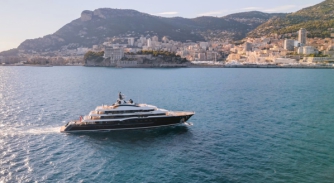Evolution of the new-build brokers
Today brokers must do more than bring cash to the table and then sign off, with clients now considered long-term assets rather than a one-time source of income…
The superyacht industry has changed immensely over the past decade, and so have the processes that drive the brokerage sector. So, within this changing landscape, is the broker an indispensable valued advisor or do they just bring in the cash flow to the big brokerage houses and then let the specialists take over?
At The Superyacht Forum in Amsterdam last year, Camper & Nicholsons’ CEO Paolo Casani, head of new build Daniela Duck and head of yacht management Marianne Denissen led a discussion exploring the intricate role of brokers in the new-build sector.
As the oldest brokerage house globally, Camper & Nicholsons has adapted alongside each evolution of the industry, maintaining its relevance in the ever-changing landscape of new builds. Contrary to the common perception that brokers merely facilitate financial trans-actions, Casani, Duck and Danissen stress that the broker’s value transcends monetary aspects, encompassing an array of critical functions within the industry.
“In comparison with 10 or 15 years ago, the market was completely different. It was easier because it was almost enough to put together a buyer with a shipyard,” explains Casani. “Today, if you want to be a leading company, you have to justify your value with both the shipyards and the client.”

Marianne Denissen, head of yacht management, Camper & Nicholsons
Ultimately, the most effective form of demonstrating your value to both clients and shipyards in the modern era comes through transparency, especially in the early stages of a purchase agreement. By managing client expectations from the start, negotiating realistic and mutually favourable contracts and ensuring brokers are educated on the latest pro-cesses and technologies, brokerage houses can ensure they not only successfully complete the initial transaction, but also establish a long-lasting bond with the client.
“There is less selling the dream and a lot more selling the reality,” says Danissen. “This makes the whole process a lot more enjoyable. Transparency has definitely increased from before, when you could sell a yacht to anybody on a more emotional basis. Yacht owners today are far more educated as well, and they want to be sure that they buy a good product.”
This clarity and reassurance are achieved through an amalgamation of processes that all begin at the initial point of purchase. Heightened awareness of all regulatory factors has become central to a broker’s role in the new-build process, particularly when it comes to regulatory matters and compliance with a shipyard’s client expectations.
“There is less selling the dream and a lot more selling the reality. This makes the whole process a lot more enjoyable.”
Given the unexplored and potentially risky legal terrain arising from Russian sanctions and their impact on regulatory frameworks, discussions in the industry have consistently revolved around addressing the ensuing legal complexities. This heightened awareness has led to more rigorous implementations of Know Your Client (KYC) processes.
“Every day, we encounter new updates and developments in terms of KYC and compliance requirements. Banks are increasingly strict, demanding detailed documentation and KYC verification,” says Casani. “[Shipyards] expect us to precisely trace the source of wealth for clients. As an international company, we have to ensure our operations are well-structured to facilitate deals across various regions. This demands a high level of organisation and adaptability to comply with diverse regulatory environments.”
Within this dynamic, maintaining relationships is paramount to the value that brokers bring to clients, especially with shipyards. But once a brokerage then follows up the purchase through the role of a project manager, some might argue that there’s a conflict of interest, with the brokers having to maintain a healthy relationship with the shipyard while also acting in the best interests of the client.
However, Casani says, “There isn’t a conflict of interest because we don’t force anyone to purchase services from us. This is also why working with a single company rather than multiple can be advantageous, as it minimises other potential conflicts.
“Internally, our company entities have different legal structures. However, operationally, they collaborate to ensure the coordination of activities, always with the client’s best interests in mind. Our goal is to provide expert advice to clients, and while having good relations with shipyards can be beneficial, it’s not our primary focus.”

Paolo Casani, CEO, Camper & Nicholsons
Brokers ultimately represent the clients, not the builders, and this is why most brokerage houses are typically independent entities rather than being owned by shipyards and then having to toe the line of acting for both parties. Casani says their role is to assist clients in selecting the best shipyard based on their expectations, budget and delivery timelines, rather than favouring one particular shipyard.
That said, the brokers also have to provide a service to shipyards. When introducing a client to the builder, it must first ascertain that the clients are fully compliant with social and regulatory requirements. This mainly addresses the point that a client must be wealthy enough to afford the yacht, minimising the risk of the project falling into jeopardy because of a client’s economic downfall.
The upsurge in new-build sales over the past few years has also led to a significant increase in issues between clients and shipyards. Shipbuilders, having secured numerous contracts, often provide delivery estimates for projects with overly optimistic timelines. However, delays have become commonplace, causing frustration among owners. Some projects are behind schedule for several months or even up to a year, intensifying tensions between clients and shipbuilders.
“It’s fundamental that the correct processes are considered in the initial phase of the contract with clearly stated clauses, penalties, grace periods, permissible delay – the goal is not to litigate.”
In moments such as these, it can be difficult for brokers to make the client understand that there’s a balance to strike. Clients are entitled to choose litigation, but they must be advised properly on what the ultimate benefit of that might be. By going down the road of litigation, owners can expect two or three years of tedious legal processes. If there’s more than a month of delay, and perhaps a subsequent loss of a season, this may not be ideal, but the end goal should always be ensuring that the client receives the quality of yacht that they expect.
“That’s why it’s fundamental that the correct processes are considered in the initial phase of the contract with clearly stated clauses, penalties, grace periods, permissible delay. The goal is not to litigate,” says Casani. “If delivery was supposed to be 20th December but it has become practically impossible, we would [already] know before the shipyard formally announces a delay because we follow the production daily and can begin to plan renegotiations accordingly. So clearly stating these things in the contract beforehand will protect the client and the project in the long run.”
Clients may not be pleased by a delay, but if brokers make them see the practical side of the situation, there are advantages. If the brokerage team can use the delay as leverage in a renegotiation and agree on different penalties such as a longer warranty, this adds a lot of value to the yacht simply because it then obliges the yard to invest in the quality of the build. It’s also much better than the alternative, with litigation likely to push back a yacht’s delivery by several years as opposed to a few months.
And sometimes, when construction is delayed, fault isn’t always only on the shipyard; the client may also bear responsibility. Production schedules are often tight and delays from prolonged decision-making or lack of communication can have significant ripple effects, potentially impacting costs and timelines for ordering components or equipment. So it’s equally important for brokers to advise their clients to make key decisions in line with the shipyard’s schedule to prevent these situations from occurring further down the line.
The art of negotiation is central to a broker’s role, but when looking at the contracts themselves, there’s always room for improvement and further evolution to ease the processes, with potential lessons to be learned in the commercial sector. Considering this, could brokers add more value to clients and shipyards by creating a standardised contract for the superyacht industry, similar to commercial maritime contracts? This could prevent yards from initiating negotiation proceedings with a contract overly favourable to their own interests, which is commonplace at the beginning of negotiations.

Daniela Duck, head of new build, Camper & Nicholsons
For example, a 50-metre offshore support vessel and a Floating Production Storage and Offloading Unit (FPSO) may be valued at £60 million and £1.2 billion respectively, but essentially have the same contract; while the spec and the instalments will be different, the overall framework will be practically identical. However, this is why the trans-jurisdictional nature of the yachting industry complicates things, particularly when compared to the likes of the commercial sector.
There’s immense potential for synergies but, unfortunately, instead of addressing crucial matters, discussions often stray from the essential topics. This is a fundamental issue that deserves attention, but while striving towards greater unity for the collective benefit of all stakeholders could be a worthy endeavour, achieving global unanimity is an almost unachievable goal.
“Even though it might be a good idea, it’s hard to actually implement this on a large scale,” explains Duck. “It could be obviously an advantage. But again, usually, it’s the builder proposing the draft and it’s often tailored to the builder’s structure, experience and skills, also in terms of following up with the project.”
“It’s challenging because we operate in various jurisdictions, each with its own set of regulations and practices,” adds Casani. “Whether it’s dealing with Turkish shipyards, Italian shipyards or those outside of Europe, navigating these differences requires an intensive effort. Ideally, industry associations would play a pivotal role in the collaboration. This approach would benefit everyone involved – shipyards, brokers and, ultimately, our clients, who are the ultimate assets we are trying to protect.”
“It’s our responsibility to educate and inform owners about the various possibilities available to them and the advantages that alternative solutions can provide, especially if they plan to enjoy their yachts for many years.”
Although brokers have had to become more educated in the aforementioned legal, regulatory and contractual intricacies, being well-versed in emerging technologies has become paramount to the broker’s value in new build, particularly with the new emergent generation of first-time buyers. According to Duck, new owners tend to be more interested in the latest propulsion systems and on-board operations that will economise their yacht’s efficiency and protect it against changing regulations in the years to come.
“It’s also our responsibility to educate and inform owners about the various possibilities available to them and the advantages that alternative solutions can provide, especially if they plan to enjoy their yachts for many years,” says Duck. “The collaborative design phase involving the shipyard, designer and owner increasingly emphasises these aspects, ensuring owners are well-informed to make sustainable decisions and explore all possibilities for building a more environmentally conscious yacht.”
The modern era demands a focus on transparency to effectively demonstrate value to both clients and shipyards. This requires upfront management of client expectations, adept negotiation of contracts that serve the interests of all parties and ensuring that brokers stay abreast of the latest industry processes and technologies. This means brokerage houses not only ensure successful initial transactions, but also lay the ground-work for enduring client relationships. To truly add value in a new-build world, brokers have to be so much more than individuals who bring the cash to the table and sign off.
“Not everyone in the brokerage industry comprehends this yet, as the primary objective often appears to be selling a yacht,” concludes Casani. “Some may question why they should concern themselves with the buyer’s long-term interests once their commission is secured. However, this mindset is fundamentally flawed. In reality, it’s imperative to prioritise the client’s needs from the outset. The client is a long-term asset, not merely a one-time source of income.”
This article first appeared in The Superyacht Report – New Build Focus. To gain access to The Superyacht Group’s full suite of content, publications, events and services, click here to join The Superyacht Group Community and become one of our members.
Profile links
CAMPER & NICHOLSONS INTERNATIONAL
NEW: Sign up for SuperyachtNewsweek!
Get the latest weekly news, in-depth reports, intelligence, and strategic insights, delivered directly from The Superyacht Group's editors and market analysts.
Stay at the forefront of the superyacht industry with SuperyachtNewsweek
Click here to become part of The Superyacht Group community, and join us in our mission to make this industry accessible to all, and prosperous for the long-term. We are offering access to the superyacht industry’s most comprehensive and longstanding archive of business-critical information, as well as a comprehensive, real-time superyacht fleet database, for just £10 per month, because we are One Industry with One Mission. Sign up here.
Related news

Brokerage readjusts to its 'old normal'
As data suggests a daunting downturn in activity, representatives from five top brokerages assess the current state of the market
Business

Sailing through economic headwinds
Will Christie shares his thoughts on the outlook for the brokerage sector in 2023
Owner

Burgess partners with Starship Yachts in Asia
Burgess and Starship Yachts have announced a partnership agreement for the Hong Kong and Macau market
Business

‘Skate to where the puck is going to be’
Tina Stow, CEO of Stow Capital LLC, reflects on her interactions with the brokerage sector.
Business

Camper & Nicholsons selects crypto partner
Through the use of BitPay, C&N creates improved customer acquisition opportunities globally
Technology
Related news
Brokerage readjusts to its 'old normal'
2 years ago
Sailing through economic headwinds
2 years ago
Burgess partners with Starship Yachts in Asia
2 years ago
‘Skate to where the puck is going to be’
3 years ago
Camper & Nicholsons selects crypto partner
3 years ago
NEW: Sign up for
SuperyachtNewsweek!
Get the latest weekly news, in-depth reports, intelligence, and strategic insights, delivered directly from The Superyacht Group's editors and market analysts.
Stay at the forefront of the superyacht industry with SuperyachtNewsweek



